Business Environment and Entrepreneurship: A Bibliometric Analysis Based on Web of Science Using VOS Viewer
Nyo Me Hlaing, XiaoKang Zha, Ullah Fawad, Tessema Shimelis Adugna
Glorious Sun School of Business and Management, Donghua University, Shanghai, China
Abstract
This study aims to conduct a bibliometric analysis of the impact of the business environment on entrepreneurs’ performance in a research context through VOS Viewer. This research extracted 402 business environment and entrepreneurship research papers from 1998 to 2024 (February) through the Web of Science (WoS) Core Collection Database. This study found that Dvorsky J. is the most significant author, and Elsevier is the most prominent publisher. The USA is the dominant player among the 76 countries surveyed, with Sambamuthy et al.’s work having the highest citation count. The research examines eight dimensions within the field, including regulatory barriers, institutional environment, organizational resources, and risk management. The study advocates for future research agendas, such as comparative analyses across diverse countries, analyzing institutional impact, social environment effects, innovation, and firm performance. This aims to encourage scholarly inquiry and inform strategic decision-making in this research field.
Keywords: business environment; entrepreneurship, bibliometric analysis, Web of Science, VOS Viewer
1. Introduction
Amidst the dynamic landscape of global development and the rapid evolution of the market economy, enterprises have access to numerous opportunities for growth and development. Meanwhile, they are also confronted with increasingly complex challenges. Policymakers and scholars have promoted entrepreneurship as a source of economic development, and many countries have adopted the impact of the business environment (BE) on entrepreneurship (Chowdhury et al., 2019). Entrepreneurship (Es) constitutes a vital component of every nation’s economic framework, exerting substantial influence on overall societal advancement (Cepel et al., 2018). It has emerged as a powerful solution to address issues related to unemployment and poverty in both developed and developing economies worldwide (Ge et al., 2022).
Researchers say that studying organizations should begin with BE because any organization’s nature, condition, and circumstances depend on its BE. They also say more research should be done on different aspects of BE on Es (Ahmad, 2015; Cepel et al., 2018; Khalid Haruna et al., 2018). BE encompasses everything that affects the company and extends beyond the organization’s sectoral boundaries or limits (Nascimento-e-Silva et al., 2019). The BE is characterized by intense competition, economic intensity, technological changes, information exchange, uncertainties about government policies, and other factors that could threaten the company’s future. BE is an ongoing transformation journey through exploration, mobilization, and stabilization. Therefore, making a conscious decision regarding the overall strategy for business transformation is imperative (Möller et al., 2020).
Entrepreneurial activity is widely acknowledged as a crucial driver for stimulating economic growth, fostering innovation, and generating employment opportunities. Particularly, the BE plays a significant role in shaping entrepreneurial activity (Estrin et al., 2007; Goel & Saunoris, 2022; Tahir & Burki, 2023). While previous studies have demonstrated the importance of BE and entrepreneurship in economic development, there needs to be a more systematic analysis regarding the current research status of this relationship. To address this gap, we conducted a bibliometric analysis of BE and entrepreneurship research from 1998 to 2024 (a 26-year period), collecting data from the Web of Science Core Database using VOS Viewer. This study aims to identify the prominent articles and research aspects related to BE and entrepreneurship, conduct a content analysis of each cluster, and outline future research directions. This study formulates three questions to guide our study:
(1) What are the bibliometric characteristics and frontier articles for the BE and entrepreneurship fields?
(2) What are the research aspects relating to BE and entrepreneurship?
(3) Which future research directions address BE and entrepreneurship?
This study is structured into five sections: theoretical review, methodology, results and discussion, cluster analysis, and future research agenda. It offers valuable insights into the intricacies of this research field, encompassing the analysis of authors, publications, articles, and geographic distribution. Moreover, this research evaluates citation mapping, cartographic analysis, and bibliographic coupling. Furthermore, it not only highlights the various aspects of the research landscape but also outlines a comprehensive agenda for future research. Lastly, this study concludes with the limitations of our study.
2. Theoretical Review
2.1. Business Environment and Entrepreneurship
Entrepreneurship is acknowledged as a pivotal driver of economic development, such as creating new enterprises and employment opportunities, income growth, poverty alleviation, innovation promotion, and bolstering competitiveness (Braunerhjelm et al., 2015; Ge et al., 2022; Urbano et al., 2020), However, the success of the entrepreneurial activity is significantly influenced by the BE in which they operate (D. Kim et al., 2023; Nascimento-e-Silva et al., 2019; Yu et al., 2023). BE refers to the total sum of factors and conditions that affect, to some extent, the behavior of market entities within the region, including factors such as the political environment, economic and market environment, legal environment, financing environment, and social service environment. BE is anything that influences business activities in an organization or company (Sambamurthy et al., 2003b). Researchers have demonstrated the advantages of enhancing BE, such as stimulating the establishment of new businesses, improving company productivity, boosting gross domestic product, fostering entrepreneurial activity, and attracting foreign direct investment (Diana Rusu & Roman, 2017; Haidar, 2012.; Nangpiire et al., 2018; Rusu et al., 2022). Furthermore, high-quality BE development can reduce enterprises’ start-up costs and entry thresholds, market uncertainty, and transaction costs, save administrative approval time, and promote the occurrence of investment activities (Hanhui Chen, 2022; Yu et al. 2012). Researchers have extensively explored the dimensions of BE in entrepreneurship, but a specific bibliometric study on different aspects of the BE and entrepreneurship research landscape has not been found. Therefore, this research initiates the bibliometric study on BE and entrepreneurship through the VOS viewer.
2.2. Bibliometric analysis and VOS Viewer
Bibliometric analysis utilizes mathematical and statistical methods to scrutinize scholarly literature, including examining publication volume, productivity, collaboration, and impact among authors and entities within a specific research field or topic. This method enables researchers to map out the intellectual structure of a field, identify key players and institutions, and track the progression of research themes over time (Ellegaard, 2018; Gauthier, 1998; Vogel & Güttel, 2013). Therefore, bibliometric analysis is a powerful method for analyzing and quantifying the impact of scholarly publications. It provides a structural approach to the literature review, including gathering information and detecting patterns. VOS Viewer, a software developed by Nees Jan Van Eck and Ludo Waltman from Leiden University, is used for constructing and visualizing bibliometric networks. It is capable of clustering scientific publications based on their co-citation or bibliographic coupling relationships, visualizing the co-occurrence of keywords, and demonstrating research trends (Van Eck & Waltman, 2010, 2017).
3. Method
This research is stimulated by three bibliometric analysis studies (Huang et al., 2022; Ullah et al., 2023; Xie et al., 2020). It presents a thorough analysis of 402 publications spanning from 1998 to 2024 that explore the relationship between the business environment and entrepreneurship. First, it applies the Web of Science Core Collection database (WOS) to collect the data and learn about the research field’s characteristics. WOS allows for identifying publication trends in business environment and entrepreneurship research, their distribution across countries, publishers, and authors, as well as the top 10 most-cited articles. Secondly, this research uses a VOS viewer for co-citation, co-occurrence, and bibliographic coupling since this software performs data mining, mapping, and clustering of the retrieved articles.
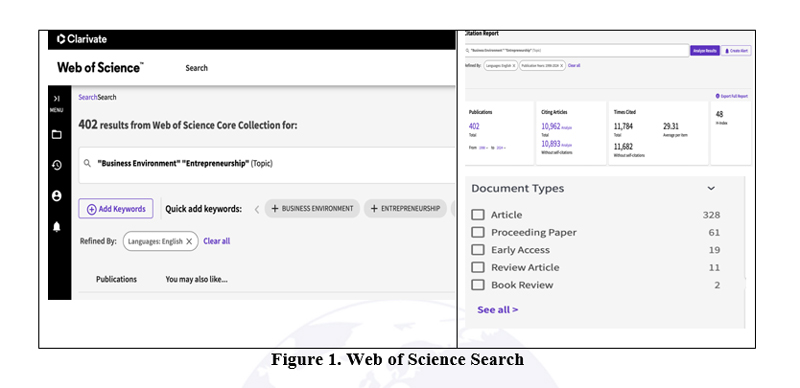

Figure 2. Citation graph
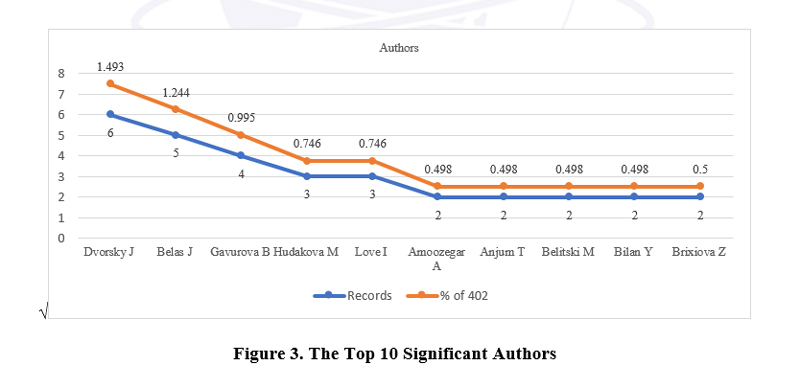
4. Findings and Discussion
4.1. Characteristics Analysis
4.1.1. Prominent Authors
The study analyzed to identify the most influential authors based on the number of records and percentage of contributions in a total of 402 articles from the WoS database. Among the 1111 authors examined, Dvorssky J emerges as the foremost contributor, boasting six records representing 1.49% of the total 402 articles considered. Dvorsky’s research highlights the multifaceted nature of business management within small and medium-sized enterprises (SMEs), covering areas such as risk management and strategic management. The runner-up author is Belas J. with 5 records, equivalent to 1.244% of the total articles, emphasizing social and financial dimensions (Belas et al., 2019). The second runner-up is Gavurova B., with four records. Subsequently, Hudakova M and Love I occupy the fourth and fifth positions, respectively. A comprehensive listing of the top 10 significant authors is presented in Figure 3.
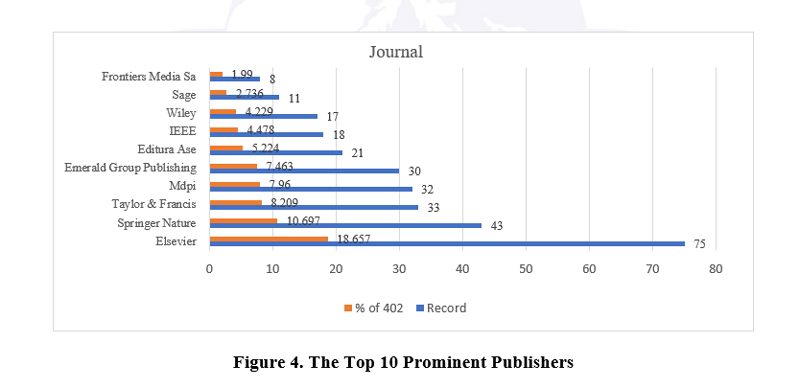
4.1.2. Prominent Publishers
Figure 4 shows the prominent publishers in the BE and entrepreneurship research fields, categorized by the number of records and percentages of total articles they represent. Among the 69 publishers, Elsevier leads the list with 75 records, which accounts for 18.657% of total articles. Springer Nature is in second place with 43 records, accounting for 10.697% of total articles. Taylor & Francis has 33 records, ranking third. Subsequent positions are held by MDPI, Emerald Group Publishing, Editua Ase, IEE, Wiley, Sage, and Frontiners Media Sa.
4.1.3. Prominent Countries
Figure 5 demonstrates the top 10 leading countries in the BE and entrepreneurship research fields. It reveals that the USA takes first place among 76 countries, making a substantial 22% contribution to the 402 articles analyzed. The People’s Republic of China secures the second position with a significant 17% contribution, while Romania captures the third spot with a commendable 17% contribution. Following in descending order are England, the Czech Republic, Slovakia, Australia, Spain, Germany, and Finland.
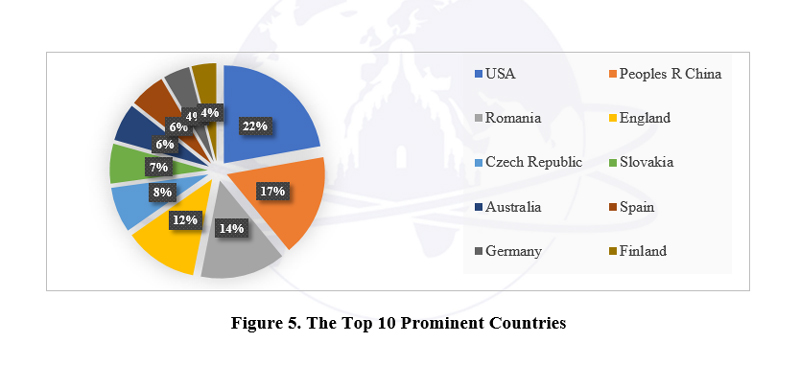
4.1.4. Prominent Articles
Table 1 reports the top 10 prominent articles in business environment and entrepreneurship, ranked by total citations. The leading light is the research of Sambamurthy et al. (2003), which has garnered 1613 citations. This study proposes the strategic significance of information technology (IT) and its multifaceted impact on firm performance significance of Information Technology (IT) and its multifaceted impact on firm performance (Sambamurthy et al., 2003). Securing the second position is the work of London et al. (2004), emphasizing successful strategies in low-income markets. Their research highlights the importance of forming relationships with non-traditional partners, co-inventing custom solutions, and building local capacity (London & Hart, 2004). Baum et al. (2003) occupy the third position, focusing on various business environments, such as the rate of environmental change, resource availability, and organizational decision-making structures (Baum & Wally, 2003). Zahra et al. (2000) take the fourth position, suggesting the importance of international corporate entrepreneurship (ICE) in the overall performance of firms. This nuanced understanding of the boundaries of ICE effectiveness provides valuable insights for firms seeking to navigate global markets strategically (Zahra & Garvis, 2000). Estrin et al. (2008) claim the fifth spot with their investigation into the role of the institutional environment in entrepreneurial development in Russia (Estrin et al., 2007). It touches on how Russia’s business environment contributes to the advantage of existing business owners over newcomers in new business start-ups.
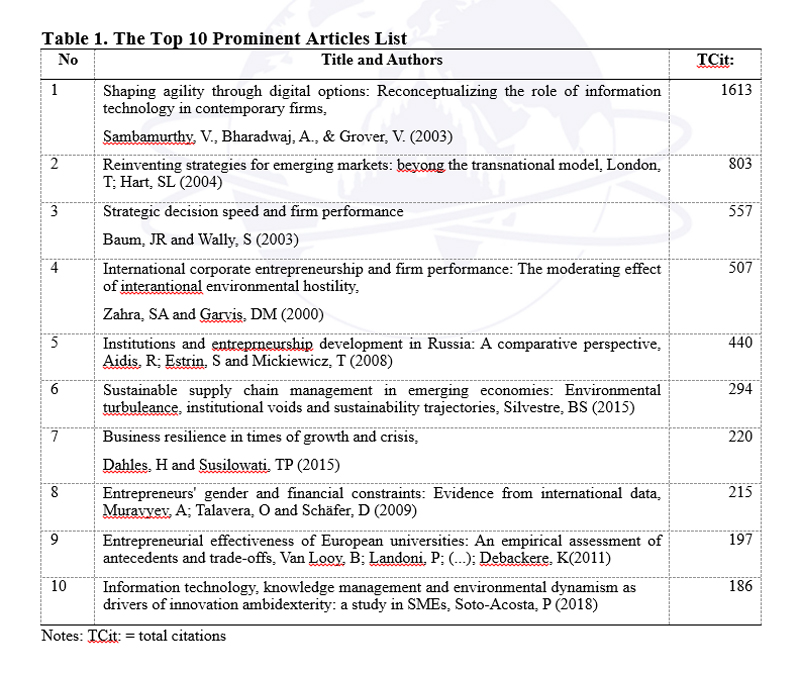
4.2. Citation Mapping, Cartography Analysis and Bibliographic Coupling
4.2.1. Citation Mapping
This study selects co-citation as the type of analysis, cited authors as the unit of analysis, and full counting as the method of analysis in generating data with VOS Viewer Software. Due to the large number of authors (12790), it sets 20 as the minimum number of citations for an author to ensure an effective and precise analysis of the business environment and entrepreneurship research mapping. The result shows that 68 authors meet the threshold with 4 clusters. Zahra, SA., Teece, DJ., and Audretsch, DJ, have the highest TLS, as shown in Figure 6.
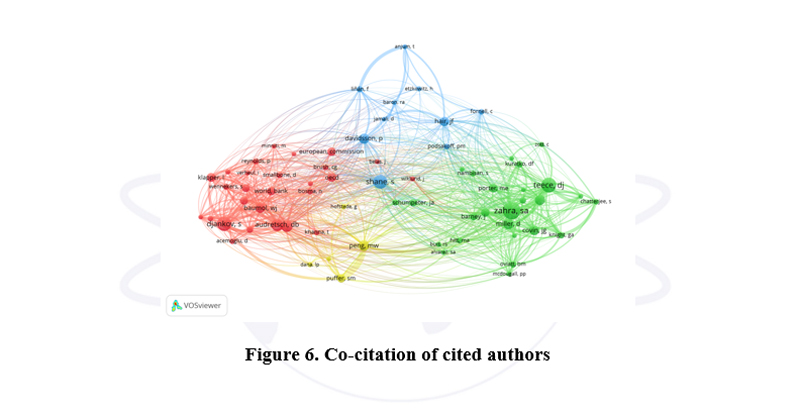
4.2.2. Cartography Analysis
This research selects co-occurrence as a type of analysis, all keywords as a unit of analysis, the full counting method, and the minimum number of occurrences of a keyword is 10. Of the 1964 keywords, 48 meet the threshold with four clusters (Figure 7). Cluster 1 is red circles group, cluster 2 is green circles group, cluster 3 is blue circles group, cluster 4 is yellow circles group. “Entrepreneurship,” “Performance,” “Innovation,” and “Business Environment” are the valves with the highest link strength. Table 2 contains detailed information about keywords, TLS, and occurrences.
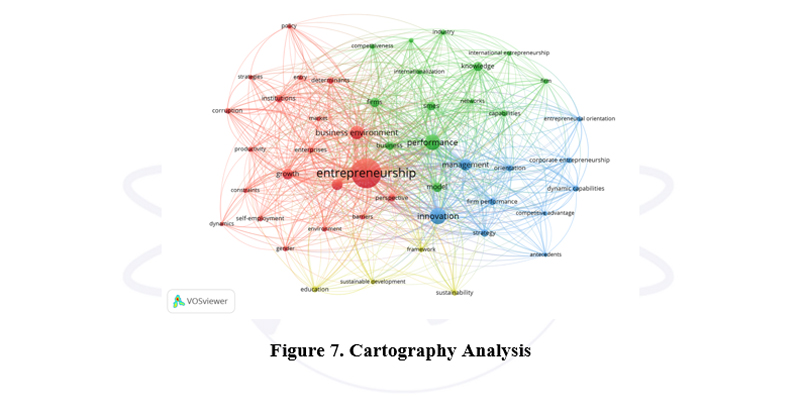

4.2.3. Bibliographic Coupling
This study selects bibliometric couples as the type of analysis, documents as the unit of analysis, and full counting. Out of 402 documents, 57 meet the minimum number of citations required for a document (40). There are total of 8 clusters under 57 documents, and Makkonen (2014), Chowdhury (2019), and Quatrato (2015) have the highest TLS. Detailed information on each cluster is described in Table 5.
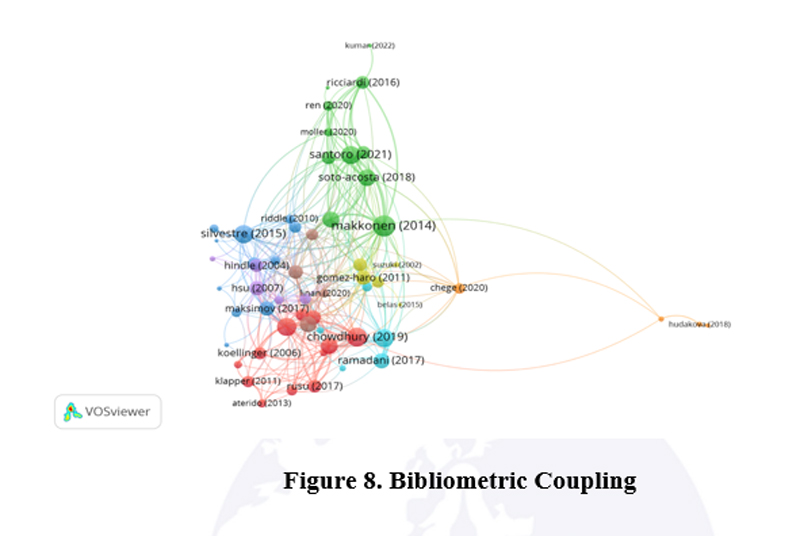
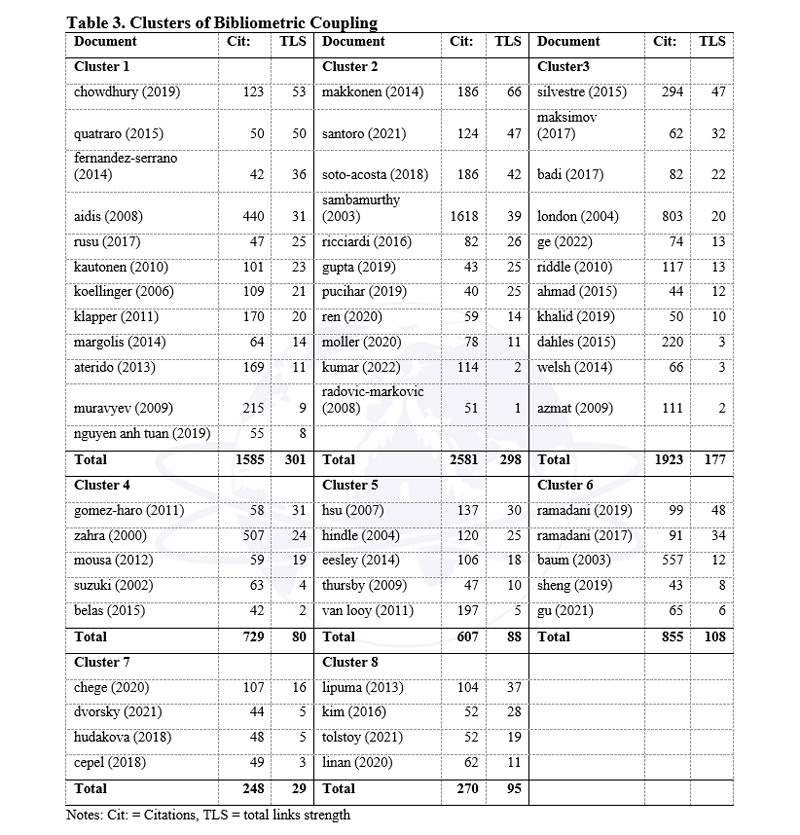
5. Cluster Analysis
To give a full picture of the articles, we looked at each individual cluster of bibliographic coupling analysis, as shown in Table 5. This table shows the weighting feature (TLS), as well as the author names and citations. The significance and importance of each research paper are determined by its weight in the particular cluster, as discussed in prior work. In bibliographic coupling analysis, links between two articles are represented by numbers that indicate their strengths, with higher values indicating stronger connections (van Eck & Waltman, 2017). Specifically, these articles are arranged in descending order of TLS, with the most prominent articles having the highest values in this research.
Cluster 1: Regulatory barriers and institutional environment
The bibliometric coupling results (Table 1) show that Cluster 1 is made up of 12 articles that talk about how formal and informal institutional factors, macroeconomic and microeconomic factors, cultural values, and regulatory barriers affect the start-up of new businesses and entrepreneurial activity (Chowdhury et al., 2019; Estrin et al., 2007; Fernández-Serrano & Romero, 2014; Quatraro & Vivarelli, 2015). These articles examine various dimensions of institutional effects on entrepreneurship, particularly concerning venture capital, government support, the absence of credit constraints, tax rates, and financial institutions (Diana Rusu & Roman, 2017; Muravyev et al., 2009).
Cluster 2: Organizational resources and capabilities
Cluster 2, consisting of 11 articles (table 5), emphasizes the influence of a company’s capability and knowledge management on its adaptability to the environment, thereby enhancing organizational efficiency and encouraging innovation (Makkonen et al., 2014; Santoro et al., 2021; Soto-Acosta et al., 2018). Some papers from this cluster highlight the pivotal role of information and technology (IT) in shaping organizational strategies and capabilities in the IT age, as well as the significant role of knowledge and capability in business model innovation (Marković, 2008; Pucihar et al., 2019). In summary, the articles in Cluster 2 primarily concentrate on capability and human resource management within the internal business environment.
Cluster 3: Supply chains management and SME’s performance
Cluster 3, comprising 11 articles, focuses on supply chain management and the performance of SMEs in developing and emerging economies. Particularly in these contexts, focal enterprises are crucial in facilitating supply chain learning, promoting innovation, and establishing supply chains (Silvestre, 2015). According to Maksimov et al. (2017), SMEs that have access to government contracts, engage in foreign market exports, or have female ownership demonstrate improved operational efficiency and higher wages for their employees (Maksimov et al., 2017).. Additionally, Badi et al. (2017) underscore the importance of building Guanxi, especially for start-ups and established businesses entering the Chinese market, suggesting strategies such as frequent communication, exchanging favors, and emotional investment (Badi et al., 2017).
Cluster 4: Corporate Entrepreneurship
Among the five articles in cluster 4, we present two that discuss corporate entrepreneurship, the most cited. Gome-Haro et al. (2011) propose that different dimensions of the institutional environment may influence the level of corporate entrepreneurship, and regulatory dimensions influence what type of corporate entrepreneurial activity is carried out (Gómez-Haro et al., 2011). Zahra et al. (2000) emphasize that companies benefit from international corporate entrepreneurship (ICE) activities by achieving higher overall performance, as well as foreign profits and revenue growth (Zahra & Garvis, 2000).
Cluster 5: Universities, knowledge, and team composition
Cluster 5, consisting of five articles, investigates the role of universities, tacit knowledge, and team composition in industry dynamics and entrepreneurial activities. Hsu et al. (2007) suggest that research universities indirectly support entrepreneurship by fostering entrepreneurial aspirations, enhancing social networks and reputations, and imparting problem-solving skills. Thursby et al. (2009) demonstrate the positive effects of university programs on students’ perceptions of the multidisciplinary capabilities necessary for operating in technological BE. Eesley et al. (2014) say that diverse founding teams are better at doing well in competitive commercialization environments than technically focused teams, which work better in collaborative settings and for coming up with new ideas (Eesley et al., 2014; Hsu et al., 2007; Thursby et al., 2009).
Cluster 6: Innovation and firm performance
Cluster 6 contains five articles that focus on innovative production and firm performance. Ramadani et al. (2019) indicate that product innovation significantly enhances firm performance in transition economies. This positive impact is reinforced by various control variables: firm size, total labor costs, and capital (Ramadani et al., 2019). The researchers also say that innovation activities are closely connected to how well a company performs because of knowledge spillover. They want the government to support R&D investment through tools like innovation vouchers, math funding of R&D costs, and tax credits (Ramadani et al., 2017).
Cluster 7: Risk management
Cluster 7 contains 4 articles that discuss risk management in SMEs. Dvorsky et al. (2021) exhibit that entrepreneurs’ attitudes toward business failure play a pivotal role in shaping the future trajectory of SMEs. Viewing financial risk positively serves as a strong indicator of financial performance, while perceiving financial risk as an integral part of daily business operations profoundly influences future business outcomes (Dvorsky et al., 2021). According to Hudakova et al. (2018), market, financial, economic, and personnel risks are the primary factors that negatively impact the business environment for SMEs. SME entrepreneurs perceive a dependency on market factors, personnel risks, and business size, whereas no such dependence is observed on financial, economic, and business risks (Hudakova et al., 2018).
Cluster 8: Export and E-commerce
Cluster 8, comprising 4 articles, explores the firm’s export orientation, export intensity, and international e-commerce. Lipuma (2013) finds that higher-quality institutions correlate positively with exporting, while financial market access and general regulations negatively affect export decisions (LiPuma et al., 2013). Firms’ export orientation and export intensity relate to their technological resources, executive experience, and characteristics of subcontracting network ties (J. J. Kim & Hemmert, 2016). Tolstoy et al. (2021) demonstrate that the evolution of international e-commerce aligns with effective frameworks, offering nuanced insights into the drivers of e-commerce internationalization (Tolstoy et al., 2021).
6. Agenda for Future Research
In this section, the agenda for future researchers is integrated from 47 articles in each cluster, focusing on suggestions related to potential factors and methods from recent papers from 2014 to 2023. Existing researchers call for future research to explore the relationship among knowledge management, dynamic capabilities, ambidextrous entrepreneurial intensity, and performance in other specific industries (Santoro et al., 2021). Some researchers call for exploring potential factors in BE and entrepreneurship, such as organizational culture, leadership, and open innovation (Soto-Acosta et al., 2018). It is suggested that more work be done on comparing and collecting data from different countries and testing the differences between the factors that affect business activity in developed and developing countries (Chowdhury et al., 2019; Diana Rusu & Roman, 2017; Fernández-Serrano & Romero, 2014; Soto-Acosta et al., 2018; Welsh et al., 2014). Some researchers suggest future research on the effect of the business environment in the SME segment at the regional or national level (Ahmad, 2015; Belás et al., 2015). For methodology, researchers recommend applying multi-methodological research, a mixed-method approach, combining qualitative and quantitative studies to gain deeper insights and understanding of the investigated phenomena, and a comparative social network analysis in entrepreneurship (Badi et al., 2017; Möller et al., 2020; Pucihar et al., 2019). Ramadani suggests further research to gather primary data ((Ramadani et al., 2017).
7. Conclusion
The research’s central goal is to understand the characteristics and bibliometric landscape of the business environment and entrepreneurship research fields. Through a thorough analysis of the WoS database, we have found significant figures and trends within this research field. Among 1111 authors, Dvorssky J emerges as the most significant author, while Elsevier stands out as the leading publisher among 69 publishers. Notably, the USA takes center stage as the most significant country among 76 countries. In terms of scholarly impact, the research of Sambamuthy et al. (2003) garners the highest citation count among the 402 articles surveyed. Employing VOS viewer software, we have identified key authors with strong citation networks, as Zahra, SA, Teece, DJ, and Audretsch, DJ, have the highest links among 68 authors. Additionally, among the 1964 keywords, “entrepreneurship,” “performance,” “innovation,” and “business environment” emerge as pivotal themes with the highest link strengths. In this bibliometic coupling analysis encompassing 57 articles, notable contributions come from Makkonen (2014), Chowdhury (2019), and Quatrato (2015), reflecting their significant TLS.
The main contribution of this study to the existing literature is to elucidate critical dimensions and point out further research agendas in the business environment and entrepreneurship research fields. Using cluster analysis based on bibliometrically coupled articles, this study identifies eight key aspects: (1) regulatory barriers and institutional environment; (2) organizational resources and capabilities; (3) supply chain management and SME performance; (4) corporate entrepreneurship; (5) universities; (6) knowledge and team composition; (6) innovation and firm performance; (7) risk management; and (8) export and e-commerce. Moreover, the research findings shed light on further research agendas for aspects and methods, mainly suggestions to extend cross-country comparisons or specific regions, apply multi-methods or mixed-method approaches, and conduct deeper investigations into the relationship between the business environment and entrepreneurial performance
8. Limitations
This study contributes to the literature gap in bibliometric analysis of the impact of BE and entrepreneurship research, but it also has some limitations. It only collects 402 papers from the WoS core collection database, which is a limitation. Future scholars can also examine data from other databases, such as SciElO, SCOPUS, Google Scholar, and so on. Next, this study focuses only on English literature. Therefore, future researchers can expand articles written in other languages, such as Chinese, Spanish, German, etc.
Conflict of Interest
The authors declared that there is no conflict of interest.
Funding
The authors did not receive any financial assistance from any institution.
Notes on Authors
First author
Ms. Nyo Me Hlaing is a Ph.D. candidate at the Glorious Sun School of Business and Management, Donghua University, Shanghai, China. The author is researching the “business environment and entrepreneurs’ performance” and is working on many more papers. She holds a Master of Accounting degree from the Shanghai National Accounting Institute in Shanghai, China. Email: nyomemopf@gmail.com
Correspondence author
Dr. Zhao XiaoKang is a professor at the Glorious Sun School of Business and Management, Donghua University, Shanghai, China. The author completed a Ph.D. in industrial economics from Fudan University, China, in 2002. Professor Zhao’s research interests include strategic management, business model innovation, financial intermediation theory, and public investment, with over 20 published articles as a first author and co-author. Besides academic commitment, Professor Zhao serves as president of the Shanghai Management Education Association, vice president of the Shanghai Engineering Management Association, and board member of the China Society of Industrial Economics. Email: zxk@dhu.edu.cn
Co-authors
Ullah Fawad, Ph.D Candidate, Glorious Sun School of Business and Management, Donghua University, Shanghai, China. Email: fawadullah1990@gmail.com
Tessema Shimelis Adugna, Ph.D Candidate, Glorious Sun School of Business and Management, Donghua University, Shanghai, China. Email: shimelis2002@gmail.com
References
Ahmad, S. Z. (2015). Entrepreneurship in the small and medium-sized hotel sector. Current Issues in Tourism, 18(4), 328–349. Https://doi.org/10.1080/13683500.2014.934211
Badi, S., Wang, L., & Pryke, S. (2017). Relationship marketing in Guanxi networks: A social network analysis study of Chinese construction small and medium-sized enterprises. Industrial Marketing Management, 60, 204–218. Https://doi.org/10.1016/j.indmarman.2016.03.014
Baum, J. R., & Wally, S. (2003). Strategic decision speed and firm performance. Strategic Management Journal, 24(11), 1107–1129. Https://doi.org/10.1002/smj.343
Belás, J., Bilan, Y., Demjan, V., & Sipko, J. (2015). AE Entrepreneurship in SME Segment: Case Study from the Czech Republic and Slovakia Amfiteatru Economic 308 ENTREPRENEURSHIP IN SME SEGMENT: CASE STUDY FROM THE CZECH REPUBLIC AND SLOVAKIA.
Braunerhjelm, P., Desai, S., Eklund, J. E., & Eklund, J. (2015). CESIS Electronic Working Paper Series Regulation, firm dynamics and entrepreneurship REGULATION, FIRM DYNAMICS AND ENTREPRENEURSHIP. Www.cesis.se
Cepel, M., Stasiukynas, A., Kotaskova, A., & Dvorsky, J. (2018a). Business environment quality index in the sme segment. Journal of Competitiveness, 10(2), 21–40. Https://doi.org/10.7441/joc.2018.02.02
Chowdhury, F., Audretsch, D. B., & Belitski, M. (2019). Institutions and Entrepreneurship Quality. Entrepreneurship: Theory and Practice, 43(1), 51–81. Https://doi.org/10.1177/1042258718780431
Diana Rusu, V., & Roman, A. (2017). Entrepreneurial activity in the EU: An empirical evaluation of its determinants. Sustainability (Switzerland), 9(10). Https://doi.org/10.3390/su9101679
Dvorsky, J., Belas, J., Gavurova, B., & Brabenec, T. (2021). Business risk management in the context of small and medium-sized enterprises. Economic Research-Ekonomska Istrazivanja , 34(1), 1690–1708. Https://doi.org/10.1080/1331677X.2020.1844588
Eesley, C. E., Hsu, D. H., & Roberts, E. B. (2014). The contingent effects of top management teams on venture performance: Aligning founding team composition with innovation strategy and commercialization environment. Strategic Management Journal, 35(12), 1798–1817. Https://doi.org/10.1002/smj.2183
Ellegaard, O. (2018). The application of bibliometric analysis: disciplinary and user aspects. Scientometrics, 116(1), 181–202. Https://doi.org/10.1007/s11192-018-2765-z
Estrin, S., Aidis, R., & Mickiewicz, T. (2007). Institutions and Entrepreneurship Development in Russia: A Comparative Perspective.
Fernández-Serrano, J., & Romero, I. (2014). About the interactive influence of culture and regulatory barriers on entrepreneurial activity. International Entrepreneurship and Management Journal, 10(4), 781–802. Https://doi.org/10.1007/s11365-014-0296-5
Gauthier, É. (1998). Bibliometric analysis of scientific and technological research: a user’s guide to the methodology.
Ge, T., Abbas, J., Ullah, R., Abbas, A., Sadiq, I., & Zhang, R. (2022). Women’s Entrepreneurial Contribution to Family Income: Innovative Technologies Promote Females’ Entrepreneurship Amid COVID-19 Crisis. Frontiers in Psychology, 13. Https://doi.org/10.3389/fpsyg.2022.828040
Goel, R. K., & Saunoris, J. W. (2022). Foreign direct investment (FDI): friend or foe of non-innovating firms? Journal of Technology Transfer, 47(4), 1162–1178. Https://doi.org/10.1007/s10961-021-09872-3
Gómez-Haro, S., Alberto, J., & Correa, A. (n.d.). Differentiating the effects of institutional environment on corporate entrepreneurship: lessons from spain.
Haidar, J. I. (2012.). The impact of Business Regulatory Reforms on Economic Growth. Https://shs.hal.science/halshs-00717423
Hanhui Chen, Peijian Wu, Lijun Hu (2012). Study on the Relationship Between Business Environment Quality and Investment: Fuzzy-Set Qualitative Comparison Analysis (fsqca) Based on the Increase of FDI and Private Investment. (2022). Journal of Global Economy, Business and Finance, 4(4). Https://doi.org/10.53469/jgebf.2022.04(04).04
Hsu, D. H., Roberts, E. B., & Eesley, C. E. (2007). Entrepreneurs from technology-based universities: Evidence from MIT. Research Policy, 36(5), 768–788. Https://doi.org/10.1016/j.respol.2007.03.001
Huang, T., Zhong, W., Lu, C., Zhang, C., Deng, Z., Zhou, R., Zhao, Z., & Luo, X. (2022). Visualized Analysis of Global Studies on Cervical Spondylosis Surgery: A Bibliometric Study Based on Web of Science Database and vosviewer. Indian Journal of Orthopaedics, 56(6), 996–1010. Https://doi.org/10.1007/s43465-021-00581-5
Hudakova, M., Masar, M., Luskova, M., & Patak, M. R. (2018). The dependence of perceived business risks on the size of smes. In Journal of Competitiveness (Vol. 10, Issue 4, pp. 54–69). Tomas Bata University in Zlín. Https://doi.org/10.7441/joc.2018.04.04
Khalid Haruna, M., Muhammad Khalid, H., Ahmad, A., & Yakubu Umar, N. (2018). Business environment and supply chain effectiveness of manufacturing industry: literature review Equity Perception and Job Satisfaction among Civil Servant in Northern Nigeria View project lapai international journal of management and social sciences (LIJOMASS) (Vol. 9, Issue 2). Https://www.researchgate.net/publication/339987653
Kim, D., Marin, M. J., Richardson, G. D., Salterio, S. E., & Tsang, A. (2023). Modeling board governance, environmental expertise, and social engagement effects on firm environmental performance: Panel data evidence. Journal of Contemporary Accounting and Economics, 19(2), 100364. Https://doi.org/10.1016/j.jcae.2023.100364
Kim, J. J., & Hemmert, M. (2016). What drives the export performance of small and medium-sized subcontracting firms? A study of Korean manufacturers. International Business Review, 25(2), 511–521. Https://doi.org/10.1016/j.ibusrev.2015.09.002
Lipuma, J. A., Newbert, S. L., & Doh, J. P. (2013). The effect of institutional quality on firm export performance in emerging economies: A contingency model of firm age and size. Small Business Economics, 40(4), 817–841. Https://doi.org/10.1007/s11187-011-9395-7
London, T., & Hart, S. L. (2004). Reinventing strategies for emerging markets: Beyond the transnational model. In Journal of International Business Studies (Vol. 35, Issue 5, pp. 350–370). Https://doi.org/10.1057/palgrave.jibs.8400099
Makkonen, H., Pohjola, M., Olkkonen, R., & Koponen, A. (2014). Dynamic capabilities and firm performance in a financial crisis. Journal of Business Research, 67(1), 2707–2719. Https://doi.org/10.1016/j.jbusres.2013.03.020
Maksimov, V., Wang, S. L., & Luo, Y. (2017). Reducing poverty in the least developed countries: The role of small and medium enterprises. Journal of World Business, 52(2), 244–257. Https://doi.org/10.1016/j.jwb.2016.12.007
Marković, M. R. (2008). Managing the organizational change and culture in the age of globalization. In Journal of Business Economics and Management (Vol. 9, Issue 1, pp. 3–11). Https://doi.org/10.3846/1611-1699.2008.9.3-11
Möller, K., Nenonen, S., & Storbacka, K. (2020). Networks, ecosystems, fields, market systems? Making sense of the business environment. Industrial Marketing Management, 90, 380–399. Https://doi.org/10.1016/j.indmarman.2020.07.013
Muravyev, A., Talavera, O., & Schäfer, D. (2009). Entrepreneurs’ gender and financial constraints: Evidence from international data. Journal of Comparative Economics, 37(2), 270–286. Https://doi.org/10.1016/j.jce.2008.12.001
Nangpiire, C., Rodrigues, R. G., & Adam, I. O. (2018). Ease of doing business and foreign direct investment inflow among Sub-Sahara African countries. International Journal of Business and Emerging Markets, 10(3), 289. Https://doi.org/10.1504/ijbem.2018.093006
Nascimento-e-Silva, D., Bento de Sousa Júnior, E., Soares Machado, A. L., Luiz Soares, M., & Breves Martins, G. (2019). Influence of the external environment on the logistics strategies of industrial organizations. International Journal for Innovation Education and Research, 7(12), 628–643. Https://doi.org/10.31686/ijier.vol7.iss12.2117
Pucihar, A., Lenart, G., Borštnar, M. K., Vidmar, D., & Marolt, M. (2019). Drivers and outcomes of business model innovation-micro, small and medium-sized enterprises perspective. Sustainability (Switzerland), 11(2). Https://doi.org/10.3390/su11020344
Quatraro, F., & Vivarelli, M. (2015). Drivers of entrepreneurship and post-entry performance of newborn firms in developing countries. World Bank Research Observer, 30(2), 277–305. Https://doi.org/10.1093/wbro/lku012
Ramadani, V., Abazi-Alili, H., Dana, L. P., Rexhepi, G., & Ibraimi, S. (2017). The impact of knowledge spillovers and innovation on firm-performance: findings from the Balkans countries. International Entrepreneurship and Management Journal, 13(1), 299–325. Https://doi.org/10.1007/s11365-016-0393-8
Ramadani, V., Hisrich, R. D., Abazi-Alili, H., Dana, L. P., Panthi, L., & Abazi-Bexheti, L. (2019). Product innovation and firm performance in transition economies: A multi-stage estimation approach. Technological Forecasting and Social Change, 140, 271–280. Https://doi.org/10.1016/j.techfore.2018.12.010
Rusu, V. D., Roman, A., Tudose, M. B., & Cojocaru, O. M. (2022). An Empirical Investigation of the Link between Entrepreneurship Performance and Economic Development: The Case of EU Countries. Applied Sciences (Switzerland), 12(14). Https://doi.org/10.3390/app12146867
Sambamurthy, V., Bharadwaj, A., & Grover, V. (2003). Shaping Agility through Digital Options: Reconceptualizing the Role of Information Technology in Contemporary Firms. In Source: MIS Quarterly (Vol. 27, Issue 2).
Santoro, G., Thrassou, A., Bresciani, S., & Giudice, M. Del. (2021). Do Knowledge Management and Dynamic Capabilities Affect Ambidextrous Entrepreneurial Intensity and Firms’ Performance? IEEE Transactions on Engineering Management, 68(2), 378–386. Https://doi.org/10.1109/TEM.2019.2907874
Silvestre, B. S. (2015). Sustainable supply chain management in emerging economies: Environmental turbulence, institutional voids and sustainability trajectories. International Journal of Production Economics, 167, 156–169. Https://doi.org/10.1016/j.ijpe.2015.05.025
Soto-Acosta, P., Popa, S., & Martinez-Conesa, I. (2018). Information technology, knowledge management and environmental dynamism as drivers of innovation ambidexterity: a study in smes. Journal of Knowledge Management, 22(4), 824–849. Https://doi.org/10.1108/JKM-10-2017-0448
Tahir, M., & Burki, U. (2023). Entrepreneurship and economic growth: Evidence from the emerging BRICS economies. Journal of Open Innovation: Technology, Market, and Complexity, 9(2). Https://doi.org/10.1016/j.joitmc.2023.100088
Thursby, M., Fuller, A., & Thursby, J. (2009). An integrated approach to educating professionals for careers in innovation. Academy of Management Learning and Education, 8(3), 389–405. Https://doi.org/10.5465/AMLE.2009.44287938
Tolstoy, D., Nordman, E. R., Hånell, S. M., & Özbek, N. (2021). The development of international e-commerce in retail smes: An effectuation perspective. Journal of World Business, 56(3). Https://doi.org/10.1016/j.jwb.2020.101165
Ullah, F., Shen, L., & Shah, S. H. H. (2023). Value co-creation in business-to-business context: A bibliometric analysis using histcite and VOS viewer. In Frontiers in Psychology (Vol. 13). Frontiers Media S.A. https://doi.org/10.3389/fpsyg.2022.1027775
Urbano, D., Audretsch, D., Aparicio, S., & Noguera, M. (2020). Does entrepreneurial activity matter for economic growth in developing countries? The role of the institutional environment. International Entrepreneurship and Management Journal, 16(3), 1065–1099. Https://doi.org/10.1007/s11365-019-00621-5
Van Eck, N. J., & Waltman, L. (2010). Software survey: vosviewer, a computer program for bibliometric mapping. Scientometrics, 84(2), 523–538. Https://doi.org/10.1007/s11192-009-0146-3
Van Eck, N. J., & Waltman, L. (2017). Citation-based clustering of publications using citnetexplorer and vosviewer. Scientometrics, 111(2), 1053–1070. Https://doi.org/10.1007/ s11192-017-2300-7
Vogel, R., & Güttel, W. H. (2013). The dynamic capability view in strategic management: A bibliometric review. International Journal of Management Reviews, 15(4), 426–446. Https://doi.org/10.1111/ijmr.12000
Welsh, D. H. B., Memili, E., Kaciak, E., & Al Sadoon, A. (2014). Saudi women entrepreneurs: A growing economic segment. Journal of Business Research, 67(5), 758–762. Https://doi.org/10.1016/j.jbusres.2013.11.040
Xie, L., Chen, Z., Wang, H., Zheng, C., & Jiang, J. (2020). Bibliometric and Visualized Analysis of Scientific Publications on Atlantoaxial Spine Surgery Based on Web of Science and vosviewer. In World Neurosurgery (Vol. 137, pp. 435-442.e4). Elsevier Inc. Https://doi.org/10.1016/j.wneu.2020.01.171
Yu, L., Tang, X., & Huang, X. (2023). Does the business environment promote entrepreneurship?——Evidence from the China Household Finance Survey. China Economic Review, 79(March), 101977. Https://doi.org/10.1016/j.chieco.2023.101977
Yu, W., & Ramanathan, R. (2013). Business environment, employee competencies and operations strategy: An empirical study of retail firms in China. IMA Journal of Management Mathematics, 24(2), 231-252
Zahra, S. A., & Garvis, D. M. (2000). International corporate entrepreneurship and firm performance: the moderating effect of international environmental hostility. In Journal of Business Venturing (Vol. 15).

Address
E-304, Mya Kyi Ryar 2nd Street, Htan Ta Pin Special Block, Dekkina Thiri Township, Naypyitaw.
Phone
(+959) 945 404 777
(+959) 882 640 707